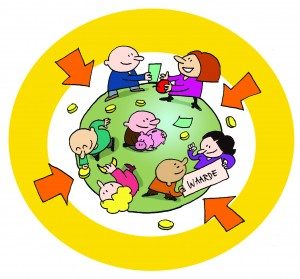By 2050, the global population will have grown to around 9.5 billion people. Unless we change our patterns of production and consumption, we risk exhausting the planet’s resources. Circular agriculture strives to close the cycles of raw materials and to make efficient use of residual flows such as animal feed to produce enough food for everyone within the boundaries set by our planet. (WUR)
However, circular farming can only exist within a circular economy (Hester Maij et al. 2019) and farmers need to get a fair price for their products to change their impact on the environment from negative (when they do) to positive.
“You cannot do green as a farmer when you are indebted, and you cannot green as a consumer when you are indebted either”
A system transformation is needed… but: a single focus on the food system limits us to look at root causes and drivers of our problems.
One of these drivers connects all of us with our food and the farmer that produced it, to the bank, nature, various initiatives for sustainable and healthy agriculture and even Co2: Money is the lubricant or motor of our economy, it makes the exchange of goods, services and investments possible.
But… money is everything from circular or sustainable, with its interest rate it drives the growth of our economy and the use of resources. Money therefore contributed to the current undesirable situation and is in the way for a real transition towards a circular agriculture.
Can we realize circular agriculture with a linear and growth-based currency?
If we look with an agroecological lens to money, we see that erosion takes place away from rural areas that need local jobs and investments and it accumulates in capital rich places. So, what if we would try to close the cycles of our money, to make money circulate longer in the region and to make money circular.
What if there was a technology that enables us to close our money cycles, stimulate the regional economy and sustainable behaviour? And what if this was up scalable, could work as a leverage point and has little trade-offs.
Complementary or local currencies are such a technology or #naturebasedsolution. It is based on ecological principles and functions alongside the national currency and connects situations where there are understaffed workers, resources and unmet needs.
It changes our behaviour because you know that when you pay (a bit more for) a fair price to a local farmer in a local currency, that this money will be spend locally again. It therefore supports local businesses, jobs and purchasing power which again enables people to pay a fair price for farmers, who can then invest in sustainable agriculture. The same works for subsidies and loans that are (partly) provided in local currencies, they stay in the region and therefore have a larger impact. The only thing is that loans are interest free!
“At the root” combines the potential of local money and local food and is a project by Emil Kuijs – Kuijseffect. Website: www.attheroot.nl email: attherootlmf@gmail.com

By United Economy
